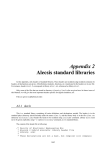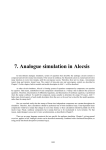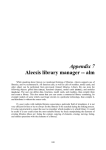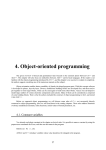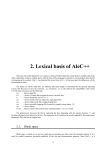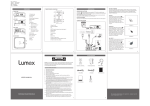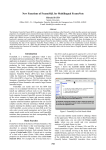Download Appendix 4 Alecsis assembler
Transcript
Appendix 4
Alecsis assembler
Virtual processor is one of the main parts of Alecsis simulation engine. It emulates the behaviour of a real
hardware processor by executing commands successively according to type. The set of legal instructions for the
virtual processor comes with adaptations and changes from the set for MC68020, Motorola microprocessor.
Text in AleC++ can be translated into the assembly language (assembler) code if you use option '-S' (file
with the extension '.as') in the program call. Besides, you can write assembler code in the text using command
asm (see chapter 2). It is not likely that the user may need assembler commands for modelling and simulation.
However, it may be necessary to understand assembler if the problems arise when installing Alecsis on
different computers.
When using assembler you can encounter some memory problems, problems with honouring various
conventions, etc., thus you need to be careful when using it. The use of assembler is tolerated only for writing of
very difficult functions whose time of execution is crucial for the program. Compiler sometimes copies interim
results into temporary registers to protect them from deleting. This can be more than necessary sometimes, but
compiler uses the safer method. Since Alecsis does not have a multipassage optimizer (besides the peephole
optimizer, which does not deal with the code as a whole but only with 2-3 neighbouring instructions), there is
always room for a shorter and more efficient code written in assembler. Optimizing can, however lead you into
dangerous waters, which require the knowledge and understanding of the work of virtual processor. Notice that
Alecsis always creates the shortest code from the given text (syntax-directed compilation). Mentioned optimizations
refer to rearrangement of some expression in order to eliminate extraneous calculations.
198
Appendix 4. Alecsis assembler
199
A4.1. Operands in assembler instructions
The cycle of the virtual processor divides into two phases: fetching of operands and execution of
instructions. Some conventions regulate what can be an assembler operand. Primary (basic) operands refer to a part
of memory called resource in Alecsis. That is an internal table containing the base addresses off all regions the
potential operands can come from. Operation fetch comes down to two additions: one when indexing resource
tables; and the other for addition of the address obtained in that way and the operand offset. The position in the
table is set using mnemonics pointing the type of the source, while offset is given by a number. Virtual processor
supports the following resource mnemonics (mnemonic always goes after the character '%').
%dn
- general purpose registers (min. 64 bytes)
%vn
- local memory (allocated using instruction link)
%fn
- formal parameter (or action parameter, inside a process)
%mn
- object passed to a function or a process (if it fits the declaration)
%an
- general purpose address registers (min. 64 bytes)
%sn
- local static memory
%_id
- identifier id (name with external linking)
(%an)
- content of memory pointed to by the address register (dereferencing)
%bn
- register pointing to resource vector
%en
- memory of the n-th element (if it has parameters)
%nn
- memory of the value of the signal at the position n (in processes) in the current time instant
The last two operands can appear in processes only, since they refer to object that can be declared only in
modules. All elements are indexed by the order of declaration, with the index 0 being the first element. Operand
points to the pointer to memory of action parameters, if the component has them. The last operand points to the
memory containing the value of the signal with the index n (formal parameters are indexed as 0, 1, 2,.., while the
local ones as -1, -2, -3, ...). To get the real address you need to multiply the index and the length of every signal in
bytes.
Beside these operands, all expressions of AleC++ can be found in instructions, including constants and
variables. For example:
int i, j = 2;
asm movq.l i, j;
The previous command copies the content of variable j into variable i. You should avoid complex
expressions, since they can use some registers in the way that creates a conflict with the current instruction.
Operand of instructions for conditional or unconditional branching can be name of a label, which can be
inside an asm region or even outside it, but within the original function or a process. The instruction itself can
have label using the syntax explained in Chapter 3.
The names of functions in the code are created using the mechanism known as name mangling (Chapter 4).
You can see how this name is created if you compile the file containing the definition of the function using the
option '-S', and read its name from the assembler file. For example, function:
200
Alecsis 2.3 - User’s manual
int foo (int, int, double**, class Point, ...);
can be called using instruction:
asm jsr %dn, %_foo_iiPPd5Point_e ;
where %dn labels the beginning of memory occupied by the function arguments. The name of the function is
prolonged with extensions, that explain which formal parameters are declared for function foo. This enables
function overloading.
When using temporary registers (%dn) you can cross over limit of 64 bytes. Actually, all registers with the
index larger than sizeof(double) will be transferred to the local memory, allocated as much as needed. This
especially refers to passing down the arguments during a function call.
A4.2. Assembler instructions
Most of instructions for virtual processor have more than one version. The current implementation of virtual
processor supports the following types: b (byte), l (long), d (double). Some instructions do not have all of these
types, or have one as default. The type is appended as the extension of the instruction mnemonics (add.1,
move.d). The type gives information about the number of bytes used by the instruction (sometime the meaning of
the instruction, too). The exception is the pair mset/movm where you can copy an unlimited number of bytes).
mset
movm
64
%_s1,
%_s2
In this example, the first 64 bytes pointed to by the external symbol s2 are copied to external symbol s1.
A4.2.1.
Instructions of Alecsis virtual processor
mnemonic
syntax
operation
supported
types
add
adda
addr
add.t
op1, op2
adda.t
op1, op2
addr.t op1, op2
%d0 = op1 + op2
%d0 = op1 += op2
%a0 = op1[ op2 ]
Indexing
b, l, d
b, l, d
b, l, d
operation has a type, to render
multiplication of the index by the type
op1 unnecessary
addq
asr
asra
band
banda
bnand
bnor
bnot
bor
bora
addq.t
op1, op2
asr.t
op1, op2
asra.t
op1, op2
band.t
op1, op2
banda.t
op1, op2
bnand.t op1, op2
bnor.t
op1, op2
bnot.t
op
bor.t op1, op2
bora.t
op1, op2
op1 += op2
%d0 = op1 << op2
%d0 = op1 <<= op2
%d0 = op1 & op2
%d0 = op1 &= op2
%d0 = op1 ~& op2
%d0 = op1 ~| op2
%d0 = ~op
%d0 = op1 | op2
%d0 = op1 |= op2
l
b,
b,
b,
b,
b,
b,
b,
b,
b,
l
l
l
l
l
l
l
l
l
Appendix 4. Alecsis assembler
bxnor
conb
cond
conl
decl
decr
devb
deva
eq
ge
gt
incl
incr
jfn
jnz
jp
jsr
201
bxnor.t op1, op2
conb.t
op
cond.t
op
conl.t
op
decl.t op
decr.t
op
dev.t op1, op2
deva.t op1, op2
eq.t
op1, op2
ge.t op1, op2
gt.t
op1, op2
incl.t op
incr.t
op
jfn
op1, findx
jnz
jp
jsr
label
label
op1, op2
%d0 = op1 ~^
op2
conversion of op from type byte
into type t
conversion of op from type double
into type t
conversion of op from type long
into type t
%d0 = --op
%d0 = op-%d0 = op1 / op2
%d0 = op1 /= op2
%d0 = op1 == op2
%d0 = op1 >= op2
%d0 = op1 > op2
%d0 = ++op
%d0 = op++
jump to the intrinsic function with the
index findx and arguments
beginning from the address op1
jump to label if %d0 != 0
jump to label
jump to function with address op2
and arguments beginning from address
b, l
b, l, d
b, l, d
b, l, d
b, l
b, l
l, d
b, l,
b, l,
b, l,
b, l,
b, l
b, l
/
d
d
d
d
/
/
/
op1
jz
le
lea
link
lsl
lsla
lt
mod
moda
move
movm
jz
le.t
lea
link.t
lsl.t
lsla.t
lt.t
mod.t
moda.t
move.t
movem
label
op1, op2
op1, op2
%b0, size
op1, op2
op1, op2
op1, op2
op1, op2
op1, op2
op1, op2
op1, op2
jump to label if %d0 == 0
%d0 = op1 <= op2
op1 = &op2
shift of the stack for t*size bytes
%d0 = op1 << op2
%d0 = op1 <<= op2
%d0 = op1 < op2
%d0 = op1 % op2
%d0 = op1 %= op2
%d0 = op1 = op2
copying of content of op2 to op1 -
/
b, l,
/
b, l,
b, l
b, l
b, l,
b, l
b, l
b, l,
/
d
d
d
d
number of copied bytes is determined
by the instruction mset
movq
mset
mul
mula
neg
neq
not
rts
sub
suba
subq
unlk
xor
movq.t op1, op2
mset op
mul.t op1, op2
mula.t op1, op2
neg.t op
neq.t op1, op2
not.t
op
rts
sub.t op1, op2
suba.t op1, op2
subq.l op1, op2
unlk %b0
xor.t
op1, op2
op1 = op2
control of instruction movm
%d0 = op1 * op2
%d0 = op1 *= op2
%d0 = - op
%d0 = op1 != op2
%d0 = !op
exit from a procedure
%d0 = op1 - op2
%d0 = op1 -= op2
op1 -= op2
return of the local memory stack
during the exit from a procedure
%d0 = op1 ^ op2
b, l,
/
b, l,
b, l,
b, l,
b, l,
b, l,
/
b, l,
b, l,
l
/
b, l
d
d
d
d
d
d
d
d
202
Alecsis 2.3 - User’s manual
xora.t
xora
A4.2.2.
op1, op2
%d0 = op1 ^= op2
b, l
Instructions of Alecsis virtual coprocessor
In the previous section, basic instruction set of virtual processor is given. Beside those instruction, virtual
processor has something you can call "coprocessor". Those are additional instructions supporting some of most
frequently used functions. This makes a program more effective, especially in the case of mathematical functions,
which are used often in modelling of analogue circuits.
mnemonic
syntax
operation
supported
types
putchar
fputc
getchar
fgetc
strcpy
strcmp
strlen
malloc
calloc
free
attr
putchar.l
op
fputc.l op1, op2
getchar.l
fgetc.l
op
strcpy.l op1, op2
strcmp.l op1, op2
strlen.l
op
malloc.l
op
calloc.l op1, op2
free op
attr.l indx, offset
%d0=putchar (op)
%d0 = fputc (op1, op2)
%d0 = getchar()
%d0 = fgetc (op)
%d0 = strcpy(op1, op2)
%d0 = strcmp(op1, op2)
%d0 = strlen(op)
%d0 = malloc (op)
%d0 = calloc (op1, op2)
free (op)
l
l
l
l
l
l
l
l
l
/
l
slen
slen.l indx, offset
fabs
exp
log
log10
pow
sqrt
sin
cos
tan
asin
acos
atan
atan2
sinh
cosh
tanh
floor
ceil
fabs.d op
exp.d op
log.d op
log10.d op
pow.d op
sqrt.d op
sin.d op
cos.d op
tan.d op
asin.d op
acos.d op
atan.d op
atan2.d op1, op2
sinh.d op
cosh.d op
tanh.d op
floor.d op
ceil.d op
returns the address of user-defined
attributes for signals with the position
indx and offset offset
returns the length of the signal-vector
with the position indx and offset
offset
%d0 = fabs (op)
%d0 = exp (op)
%d0 = log (op)
%d0 = log10 (op)
%d0 = pow (op)
%d0 = sqrt (op)
%d0 = sin (op)
%d0 = cos (op)
%d0 = tan (op)
%d0 = asin (op)
%d0 = acos (op)
%d0 = atan (op)
%d0 = atan2 (op1, op2)
%d0 = sinh (op)
%d0 = cosh (op)
%d0 = tanh (op)
%d0 = floor (op)
%d0 = ceil (op)
You can use coprocessor instructions by honouring standard conventions.
l
l, d
d
d
d
d
d
d
d
d
d
d
d
d
d
d
d
d
d
Appendix 4. Alecsis assembler
203
A4.3. Conventions on passing parameters to functions
The mechanism of function call and the return from functions, used by the virtual processor, will be
explained on the following example.
int z;
main () {
int x, y;
z = test (x, y);
}
test (int i, int j) {
int k;
k = i + j;
return (k);
}
This code would be compiled as follows (comments in the code are added):
_main:
link.l %b0, 4
// allocating 16 bytes of local space
movq.l %d8, %v0
// placing variable i (%v0) into the first
// available register after the accumulator (%d0 to %d7)
movq.l %d12, %v4
// placing variable j into the next one
jsr %d8, _test_ii //call of func. test (the name is completed)
movq.l %_z, %d0
// result returned via %d0
L0:
unlk %b0
// freeing local space
rts
// end of function
_test_ii:
link.b
add.l
movq.l
movq.l
jp
%b0,
%f0,
%v0,
%d0,
L0
4
%f4
%d0
%v0
//
//
//
//
//
//
allocating 4 bytes of local space
adding of formal variables i and j
storing the result into the variable k
return of the result
compulsory jump to the output label (to
free the space allocated using link
L0:
unlk %b0
rts
// freeing local space
// end of function
The arguments are passed in the following manner - they are lined up continually into the register %dn,
starting from the first free position (the lowest position is %d8, since the accumulator occupies the first 8 bytes).
Instruction link allocates space for all local variables and all interim results that were on locations %d8+n. In our
example function main has two local variables of type int (2x4 bytes) and uses two positions of a register %d to
pass arguments (2x4 bytes, totalling 16 - since we used long variant of instruction link, this number is divided by
sizeof(long)). Function test allocates space only for its local variable k. The result of the function is
returned through the accumulator (from %d0 to %d7). After that, the program jumps to label L0 where it frees
local space, and exits from the function. The results larger than 8 bytes return to address %f0 (address of formal
parameters), using instruction movm.
The previous example can be realized using combined AleC++/assembler syntax:
int z;
204
Alecsis 2.3 - User’s manual
main () {
int x, y;
asm {
movq.l %d8, x
movq.l %d12, y
jsr
%d8, %_test_ii
movq.l z, %d0
}
}
test (int i, int j) {
int k;
asm {
add.l i, j
movq.l k, %d0
}
return (k);
}
This example leaves instructions link and inlk to the compiler (this is a standard procedure when using
asm command). This applies in both cases to command return, too
In pointer arithmetic, you should be careful when dealing with address registers. Register %a0 is reserved
for vector indexing. Therefore, the code:
int i,j, a[10], b;
b = a[i+j];
compiles to
add.l i, j
addr.l a, %d0
movq.l b, (%a0)
which means that the instruction addr puts the address &a + sizeof(long)*(i+j) into the address
register %a0. The following instruction copies the content of that address in the register into variable b.
Parentheses can dereference only address registers. To dereference a pointer, you need to transfer it into
an address register:
int *i, j[10];
j[2] = *i;
This code is equivalent to the following code:
addr.l j, 2
movq.l %a4, i
movq.l (%a0), (%a4)
Note that pointer occupy 4 bytes, so the first free place was %a4, after %a0 had been used.
Instruction lea does the referencing:
int i, j;
j = &i;
lea %d0, i
Appendix 4. Alecsis assembler
205
movq.l j, %d0
Compiler implements referencing in two steps, but it is the standard procedure for the optimizer to merge
two steps into one: lea j, i.
Built-in functions are called using command jfn, and they cannot be mixed with ordinary functions, since
their address cannot be obtained. The first operand is the address of the first argument, while the second one is an
integer constant used for indexing. Indexes of all intrinsic functions, that are not instructions, are in the file asm.h
in directory alecsis/include. The following is the content of the file.
#define
#define
#define
#define
#define
#define
#define
#define
#define
#define
#define
#define
#define
#define
#define
#define
#define
#define
#define
_printf
_fprintf
_sprintf
_fflush
_fopen
_fclose
_feof
_fseek
_ftell
_fread
_fwrite
_rewind
_exit
_system
_warning
_drand
_get_info
_atof
_atoi
0
1
2
3
4
5
6
7
8
9
10
11
12
13
16
17
21
27
28
The missing indices are used for internal system functions, which only compiler can call. By appending this
library you can write:
movq.l %d8, "Hello, world!\n"
jfn
%d8, _printf
which has the same effect as AleC++ command:
printf("Hello, world!\n").
You can find all other details linked with using assembler by compiling the source code using option '-S'
and by direct comparison of source and compiled code. Notice that you cannot use directly the code obtained in this
manner. Assembler instructions need to be inside asm command for compiler to accept them. The closing example
will be a recursive function for calculating the factorial of 170 in double precision:
#include <alec.h>
double factor (double i){
if (i<=1) return 1.0;
return i * factor (i-1.);
}
int main() {
double i=170.;
printf("\tfactor(%g)=%g\n", i, factor (i));
}
//
206
Alecsis 2.3 - User’s manual
// Alecsis assembler code
//
// optimization off
//
// function factor_d
_factor_d:
link.b
le.d
movq.l
jz L1
movq.d
jp L0
L1:
sub.d
movq.d
jsr
mul.d
movq.d
jp L0
L0:
unlk
rts
%b0, 8
%f0, 1
%d0, %d0
%d0, 1
%f0,
%v0,
%v0,
%f0,
%d0,
1
%d0
_factor_d
%d0
%d0
%b0
//function main
_main:
link.b
movq.d
movq.l
movq.d
movq.d
jsr
movq.d
jfn
L0:
unlk
rts
%b0, 28
%v0, 170
%v8, "\tfactor(%g)=%g\n"
%v12, %v0
%v20, %v0
%v20, _factor_d
%v20, %d0
%v8, 0
%b0










